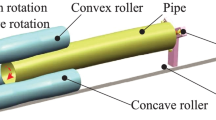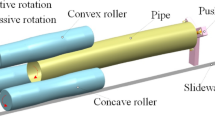Abstract
In this paper, a mechanical model of axial and circumferential bidirectional deformation has been developed by considering two factors: roller shape and radial reduction. Since the calibration of the roundness and that of the straightness of pipes are currently separate processes, the established mechanical models are based on a single direction. However, the established bidirectional mechanical model can describe not only the stress-strain distribution of the pipe in deformation to determine the position of the stress concentration but also the deformation curve of the pipe in different directions. As a result, it can serve as a theoretical basis for setting process parameters and optimizing roller shape. A large thin-walled pipe of Al6063 is modeled and then numerically simulated with FEM software of ABAQUS, and the results are compared with the model. Then, the process is fabricated and tested experimentally. The results are compared with the mechanical and numerical models. The distribution of equivalent stress and equivalent strain obtained by the model has a good match with the simulation results, and the maximum relative error is not more than 25%. The axial and circumferential deformation curve calculated by the mechanical model coincides well with the simulation and experimental results, and the maximum error is not greater than 3.0 mm. Obviously, both the experiment and the simulation have verified a superior validity of the model.
Graphical abstract

A mechanical model of axial and circumferential bidirectional deformation has been developed by considering two factors: roller shape and radial reduction. The model can describe not only the stress-strain distribution of pipes in deformation to determine the position of the stress concentration but also the deformation curve of pipes in different directions. It provides a theoretical basis for the setting of process parameters and the optimization of roller shape.



























Similar content being viewed by others
References
Li HL (2001) Some hot issues of research and application for natural gas transmission pipes. China Mechan Eng 12:349–352
Trifonov OV, Cherniy VP (2012) Elastoplastic stress–strain analysis of buried steel pipelines subjected to fault displacements with account for service loads. Soil Dyn Earthq Eng 33(1):54–62. https://doi.org/10.1016/j.soildyn.2011.10.001
Trifonov OV, Cherniy VP (2010) A semi-analytical approach to a nonlinear stress–strain analysis of buried steel pipelines crossing active faults. Soil Dyn Earthq Eng 30(11):1298–1308. https://doi.org/10.1016/j.soildyn.2010.06.002
Papadaki CI, Karamanos SA, Chatzopoulou G, Sarvanis GC (2018) Buckling of internally-pressurized spiral-welded steel pipes under bending. Int J Press Vessel Pip 165:270–285. https://doi.org/10.1016/j.ijpvp.2018.07.006
Draper S, Griffiths T, Cheng L, White D, An H (2018) Modelling changes to submarine pipeline embedment and stability due to pipeline scour. 37th International Conference on Ocean, Offshore & Arctic Engineering: OMAE2018 (22/06/18).
Chatzopoulou G, Karamanos SA, Varelis GE (2015) Numerical simulation of UOE pipe process and its effect on pipe mechanical behavior in deep-water applications. Proceedings of the ASME 2015 34th International Conference on Ocean, Offshore and Arctic Engineering. Volume 5B: Pipeline and Riser Technology. St. John’s, Newfoundland, Canada. May 31-June 5. V05BT04A036. ASME. https://doi.org/10.1115/OMAE2015-41457
Robertson M, Griffiths T, Viecelli G, Oldfield S, Ma P, Al-Showaiter A, Carneiro D (2015) The influence of pipeline bending stiffness on 3D dynamic on-bottom stability and importance for flexible flowlines, cables and umbilicals[C]// ASME 2015 34th International Conference on Ocean, Offshore and Arctic Engineering. DOI: https://doi.org/10.1115/OMAE2015-41646
Zhao J, Zhan PP, Ma R, Zhai RX (2014) Prediction and control of springback in setting round process for pipe-end of large pipe. Int J Press Vessel Pip 116:56–64. https://doi.org/10.1016/j.ijpvp.2014.01.006
Yu GC, Zhao J, Ma R, Zhai RX (2016) Uniform curvature theorem by reciprocating bending and its experimental verification. Chin J Mechan Eng 52:57–63. https://doi.org/10.3901/JME.2016.18.057
Huang XY, Yu GC, Zhao J, Mu ZK, Zhang ZY, Ma R (2020) Numerical simulation and experimental investigations on a three-roller setting round process for thin-walled pipes. Int J Adv Manuf Technol 107:355–369. https://doi.org/10.1007/s00170-020-05087-2
Wang CG, Yu GC, Wang W, Zhao J (2018) Deflection detection and curve fitting in three-roll continuous straightening process for LSAW pipes. J Mater Process Technol 255:150–160. https://doi.org/10.1016/j.jmatprotec.2017.11.060
Cui F, Yang HL (2015) New understanding in the field of straightening theory. Heavy Machin 1:2–5. https://doi.org/10.3969/j.issn.1001-196X.2015.01.001
Zhao J, Yu GC, WANG HR (2017) A roller-type continuous and synchronous calibrating straightness and roundness equipment and processing method for pipes. Hebei: CN106623507A, 2017-05-10.
Karamitros DK, Bouckovalas GD, Kouretzis GP (2007) Stress analysis of buried steel pipelines at strike-slip fault crossing. Soil Dyn Earthq Eng 27:200–211. https://doi.org/10.1016/j.soildyn.2006.08.001
Zhao J, Yu GC, Ma R (2016) A mechanical model of symmetrical three-roller setting round process: the static bending stage. J Mater Process Technol 231:501–512. https://doi.org/10.1016/j.jmatprotec.2016.01.002
Song HP, Xie KK, Gao CF (2020) Progressive thermal stress distribution around a crack under Joule heating in orthotropic materials. Appl Math Model 86:271–293. https://doi.org/10.1016/j.apm.2020.04.022
Zhang ZQ (2019) Modeling and simulation for cross-sectional ovalization of thin-walled tubes in continuous rotary straightening process. Int J Mech Sci 153-154:83–102. https://doi.org/10.1016/j.ijmecsci.2019.01.021
Taheri-Behrooz F, Pourahmadi E (2018) Mutual effect of Coriolis acceleration and temperature gradient on the stress and strain field of a glass/epoxy composite cylinder. Appl Math Model 59:164–182. https://doi.org/10.1016/j.apm.2018.01.036
Cheng X, Guo XZ, Tao J, Xu Y, Abd El-Aty A, Liu H (2019) Investigation of the effect of relative thickness (t/d) on the formability of the AA6061 tubes during free bending process. Int J Mech Sci 160:103–113. https://doi.org/10.1016/j.ijmecsci.2019.06.006
Yu GC, Zhai RX, Zhao J, Ma R (2018) Theoretical analysis and numerical simulation on the process mechanism of two-roller straightening. Int J Adv Manuf Technol 94(9):4011–4021. https://doi.org/10.1007/s00170-017-1120-5
Zhang ZQ, Yan YH, Yang HL, Wang L (2015) Modeling and analysis of the limit bending-radius for straightening a thin-walled tube with equal curvature. J Mechan Strength 37:651–656. https://doi.org/10.16579/j.issn.1001.9669.2015.04.013
Zhao J, Yin J, Ma R, Ma LX (2011) Springback equation of small curvature plane bending. Sci China Technol Sci 54:2386–2396. https://doi.org/10.1007/s11431-011-4447-4
Zhou Z, Qin LL, Huang WB, Wang HW (2004) Effective stress and strain in finite deformation. Appl Math Mech 25(5):542–550. https://doi.org/10.3321/j.issn:1000-0887.2004.05.013
Karafi M, Kamali S (2021) A continuum electro-mechanical model of ultrasonic Langevin transducers to study its frequency response - ScienceDirect. Appl Math Model 92:44–62. https://doi.org/10.1016/j.apm.2020.11.006
Acknowledgements
The authors would like to thank the National Natural Science Foundation of China, National Natural Science Foundation of Hebei province, and National Major Science and Technology Projects of China for their financial support.
Funding
This project was funded and supported by the National Natural Science Foundation of China (grant number 52005431), National Natural Science Foundation of Hebei province (grant number E2020203086), and National Major Science and Technology Projects of China (grant number 2018ZX04007002).
Author information
Authors and Affiliations
Contributions
Xueying Huang: conceptualization, methodology, validation, formal analysis, investigation, data curation, writing - original draft, writing - review and editing, software, visualization.
Gaochao Yu: conceptualization, methodology, formal analysis, supervision, writing - review and editing.
Honglei Sun: conceptualization, methodology, formal analysis, supervision.
Jun Zhao: conceptualization, methodology, formal analysis, supervision.
Corresponding author
Ethics declarations
Ethics approval
The authors declare that this manuscript was not submitted to more than one journal for simultaneous consideration. Also, the submitted work is original and not have been published elsewhere in any form or language.
Consent to participate and publish
The authors declare that they participated in this paper willingly and the authors declare to consent to the publication of this paper.
Conflict of interest
The authors declare no competing interests.
Additional information
Publisher’s note
Springer Nature remains neutral with regard to jurisdictional claims in published maps and institutional affiliations.
Appendices
Equation (30) can be simplified as follows:
If a is made to be 3b12 − 3r2, b is 3b14 − 7b12r2 + 3r4, c is b16 − 3b14r2 + 3b12r4 − r6, and a12 is y, the following equations can be obtained.
By substituting y = x − a/3 into Eq. (45), the form of x3 + px + q = 0 can be given as follows:
where \( p=b-\frac{a^2}{3} \); \( q=\frac{2{a}^3}{27}+c-\frac{ab}{3} \). A real number solution is given by Eq. (46), such as Eq. (47).
The following conclusions can be drawn, as shown in Eq. (48).
The curve PQ can be obtained by substituting Eqs. (48) and (28) into Eq. (26).
Substituting Eq. (37) into Eq. (36), and making a 2 2 = z, x 2 2 = z + m 2 2, the cubic equation with a variable z can be expressed as follows:
where \( {m}_2=r\sin \frac{2\pi -6\arcsin \frac{m_1}{r}}{6} \) (see Appendix C for details). Similarly, the following can be obtained by making e = 6m22 − r2, f = 12m24, and g = 8m26.
Let \( z=x-\frac{e}{3} \) and substitute it into Eq. (51); Eq. (52) can be obtained.
where \( {p}_1=f-\frac{e^2}{3} \), \( {q}_1=\frac{2{e}^3}{27}+g-\frac{ef}{3} \). A real number solution is given by Eq. (52), such as Eq. (53).
The following conclusions can be drawn, as shown in Eq. (54).
By substituting Eq. (54) into Eq. (35), the curve WT can be expressed as follows:
As can be seen from the fact that three reverse bending regions and three positive bending regions are evenly distributed across the circular cross-section of the pipe, the angle corresponding to the region is also evenly distributed.
where θT is the angle corresponding to the reverse bending region, and θF is the angle corresponding to the positive bending region. The geometric relationship can be obtained in Fig. 13 and Fig. 14.
Equation (57) is substituted into Eq. (56), and Eq. (58) and Eq. (59) can be obtained.
Rights and permissions
About this article
Cite this article
Huang, X., Yu, G., Sun, H. et al. A mechanical model of axial and circumferential bidirectional deformation for large thin-walled pipes in the process of continuous and synchronous calibration of roundness and straightness by three rollers. Int J Adv Manuf Technol 116, 3809–3826 (2021). https://doi.org/10.1007/s00170-021-07479-4
Received:
Accepted:
Published:
Issue Date:
DOI: https://doi.org/10.1007/s00170-021-07479-4




